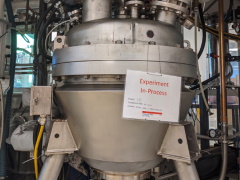Features
Wood good for one pot
Date: 2021-04-30 15:23:26.0
Author: Jon Evans

The single tank for converting wood into
fermentable sugars.
Photo: Berkeley Lab.
Up to now, bioethanol has mainly been produced from herbaceous plants. Even then, only bioethanol produced from starch- or sugar-rich crops has been widely commercialized, because of the difficulties of producing bioethanol from general plant biomass, such as crop residue and energy grasses.
What bioethanol has not generally been produced from is wood, despite it being widely available. This is because wood is even more difficult to convert into bioethanol than herbaceous plant biomass. Not only does it contain higher amounts of lignin and more crystalline cellulose, but this also means it requires harsher measures to break it down, producing more toxic substances that can harm the enzymes and microbes used in subsequent steps.
Now, however, a team of scientists from Lawrence Berkeley National Laboratory and Sandia National Laboratories, both in California, US, led by John Gladden from Sandia, has developed the first one-pot process for efficiently producing bioethanol from wood. The long and winding route to this one-pot process is described in two papers in ACS Sustainable Chemistry & Engineering.
The first paper details the development of the separate steps in this process. The initial pre-treatment step involves breaking down the wood with an ionic liquid, which is an approach many researchers have investigated (see An equal relationship). But Gladden and his team specifically looked at ionic liquids that could be produced from naturally occurring materials and used in an aqueous solution, with the aim of reducing the generation of toxic substances. They eventually alighted on an ionic liquid called cholinium lysinate, which they mixed with water to form a solution in which the ionic liquid accounted for just 10%.
The next steps in the process are basically the same as any other process for producing bioethanol from plant biomass. Gladden and his colleagues added a commercially available mix of enzymes to the hydrolysate produced by the pretreatment process, to convert the released cellulose and hemicellulose into glucose and xylose respectively. They then fed this glucose and xylose to a strain of Saccharomyces cerevisiae developed by Novozymes that could ferment both sugars into ethanol. Finally, they extracted the ethanol by distillation.
They tested this process on various different types of wood, finding that it worked best on a mix of softwood and hardwood, specifically a mix of almond, walnut and pine wood. Gladden and his colleagues were able to convert over 90% of this wood mix into glucose and xylose, resulting in an ethanol yield of 17.9g per liter of hydrolysate and a fermentation efficiency of 61%.
In the second paper, Gladden and his colleagues report their efforts to optimize these steps and then combine them into a single one-pot process. They explored various options for optimization, including varying the wood loading, and the pH and temperature of each step, and acclimatizing the yeast culture.
Once optimized, they combined these steps into a single process, although not quite in a single pot, because after the sugar-producing step they transferred the hydrolysate into a separate fermentation tank. At no stage, however, was the hydrolysate separated into distinct fractions, saving time and expense.
They tried this process at various scales, culminating in a 680L pilot-scale fermentation, which achieved a deconstruction efficiency of over 80%, a fermentation efficiency of over 90% and an ethanol yield of 27.7g per liter of hydrolysate. Gladden and his colleagues calculated that this would allow bioethanol to be produced from wood at a cost of $8.8 per gasoline gallon equivalent (gge), which is still too expensive to compete with petroleum. But they are confident that with a few further tweaks to the process, they could bring this down to just $3/gge. They are already working with Aemetis, a California-based advanced renewable fuels company, to commercialize the process.
Turning wood into bioethanol could prove especially useful in California, as a way to prevent the wildfires that have devastated the state over the past few years. "Removing woody biomass from forests, like the overgrown pines of the Sierra, and from agricultural areas like the almond orchards of California's Central Valley, we can address multiple problems at once: disastrous wildfires in fire-prone states, air pollution hazards from controlled burning of crop residues, and our dependence on fossil fuels," said team member Lalitendu Das from Sandia.
The views represented here are solely those of the author and do not necessarily represent those of John Wiley and Sons, Ltd. or of the SCI.
Displaying 2 keywords used to tag this article:
- Jules Audemars-Australia Best Quali
- DG6582 Mens Moncler Down Jackets Gr
